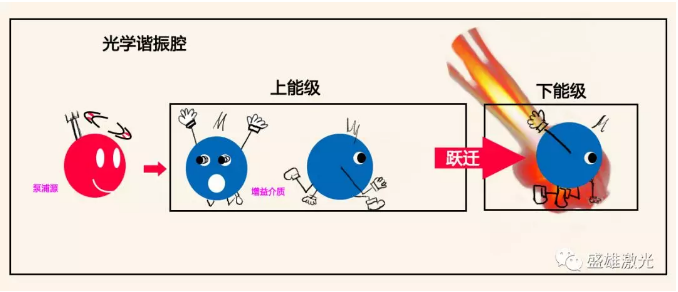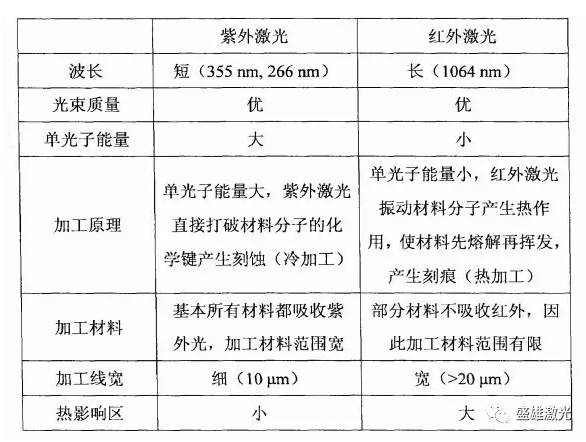Release Date:2020.04.21 Views:652 Source:
Laser generation
From a textual point of view, laser research originates from the West. The English language is laser, which is the acronym for Light Amplification by Stimulated Emission of Radiation, which translates to "light amplification caused by stimulated radiation." From a scientific point of view, the laser is that atoms or molecules are excited (pumped/pumped) in the working medium (gain medium), from the low energy level (ground state/upper energy level) to the higher energy level (excited state/lower energy level) During the transition, light of a specific wavelength is radiated.

Laser generation principle
Laser characteristics
Monochromatic
Directionality
Coherence
Energy concentration
UV laser
Ultraviolet lasers used in lasers are mainly divided into gas lasers and ultraviolet solid-state lasers. At present, gas ultraviolet lasers used for laser processing are mainly excimer lasers and argon ion lasers. However, these lasers have shortcomings in applications, such as: large equipment footprint, limited reliability, short life, high energy consumption, high equipment maintenance costs, and the need to regularly replace toxic gas or liquid fuel. Moreover, the quality of the excimer laser beam is poor, and a light-shielding film is needed, which will lose 95% or more of the output energy: helium-cadmium lasers and ion lasers also have the disadvantage of poor beam pointing stability.
Due to its high efficiency, high repetition rate, reliable performance, compact structure, good beam quality and high power stability, the research of LD pumped all-solid-state UV lasers has very important significance and relatively good application prospects. . All-solid-state UV lasers have been widely used in the semiconductor industry, material preparation, all-optical optical device manufacturing, integrated circuit boards and bioengineering.
Combining all-solid-state lasers with nonlinear frequency conversion technology is currently the most commonly used method to obtain all-solid-state UV laser output. It is the most mature UV light source generation scheme to generate the third, fourth, or fifth harmonic by converting the frequency of the near-infrared light of the neodymium-ion-doped solid-state laser near 1.0 pum. At present, in industrial developed countries such as Germany, the United States and Japan, UV lasers have become the standard lasers for industry, and 355 nm UV lasers with an average power of 5-10 W have reached the practical level.

Application of ultraviolet laser
In the field of device processing, the use of ultraviolet lasers to process devices has some special advantages over infrared light with longer wavelengths:
First of all, infrared light or visible light is usually processed by means of generating local heat to melt or vaporize the device. This processing method will cause serious damage to the structure around the processed area, thus limiting the edge strength of the device and the ability to produce fine features; and ultraviolet Laser processing is to directly destroy the chemical bonds connecting the atoms of the substance. This "cold" process of directly separating the substance into atoms does not heat the processing area.
Secondly, because many glass and crystal materials have a strong absorption effect on ultraviolet light (below 300nm), the absorption effect on near infrared and visible light is weak. Therefore, in actual production, it is impossible to process such materials with near-infrared light or visible light. On the contrary, it can be processed with ultraviolet lasers.
In addition, the ability of fine processing due to the shorter wavelength of the ultraviolet laser makes it have a higher spatial resolution; it also makes it possible to perform fine processing such as drilling and cutting of many substances such as metals and semiconductors.
Infrared laser
The mid-infrared band with a wavelength range of about 2-5 microns has many unique optical characteristics, and has wide application potential in many fields such as medicine, biology, communications, and military. At the same time, the mid-infrared laser is safe for human eyes and has a strong atmospheric penetration ability. Therefore, it is also widely used in weather monitoring, space optical communication, laser ranging, lidar, laser guidance, remote sensing, etc. Applications. However, the current research on mid-infrared light sources in the industry mainly uses crystals as the medium. However, due to the limitations of crystals, there are defects such as large size and high cost. Therefore, it is very urgent to study higher-performance mid-infrared light sources. The chalcogenide glass optical fiber has the characteristics of low loss and high nonlinear refractive index coefficient, and has gradually entered the sight of researchers in recent years.

Comparison of infrared laser and ultraviolet laser
Green laser
Green laser has the advantages of high brightness, small focusing spot, short action time, small heat affected zone, and large deformation of the workpiece during processing. It can accurately process special materials with high hardness and brittleness. Therefore, green light Lasers have unique advantages in precision machining. Compared with the infrared band DPSSL, high-power green light has the characteristics of shorter wavelength, longer focal depth, high laser energy utilization, and narrower beam width of laser beam. Therefore, high-power green light laser can be used for dicing of ceramics With drilling. In terms of laser cutting of PCB boards, high-power green lasers have the advantages of low cost and high average power compared to ultraviolet lasers, and have a higher cost performance. In the field of silicon solar cell processing, silicon materials have a very high absorption of 532 nm green light. Compared with ultraviolet lasers, high-power green light is more efficient at scribing and drilling silicon wafers. DPSSGL can also be used for the micro-welding of metal materials. The low-power 532nm laser is used to melt the material without vaporization. After cooling, a continuous solid structure is formed to achieve micro-welding of metal materials. American MiyachiUnitck company, using 532nm Nd: YAG quasi-continuous laser to successfully achieve copper micro-welding on copper bars. In addition, the green laser can also be used for laser marking and precision processing of materials such as glass, plastic, aluminum and its alloys.
With the rapid development of all-solid-state laser technology, Q-switching technology and nonlinear frequency conversion technology, all-solid-state lasers are developing toward high-power, high-stability, multi-band, and tunable research directions, of which development is rapid and relatively mature Diode Pumped Solid-State Green Laser (DPSSGL) is a two-diode pumped semiconductor laser. All-solid-state green lasers are increasingly used in scientific research, laser medical treatment, laser processing, military defense, and laser display. In the field of color display technology, compared with other display technologies, laser display technology has the unique advantages of large color gamut, bright colors, flexible display screen size, and no harmful electromagnetic radiation. It is displayed in home smart theaters and large public screens. , Virtual reality, teaching demonstrations and many other fields have huge market development space and prospects.
Reference original
[1]Zhang Baitao, (2012), Research on high-power all-solid-state 355mm ultraviolet laser, Shandong University, PhD thesis.
[2]Hu Miao, (2008), Research on the BBO crystal quadruple frequency ultraviolet laser, Zhejiang University, PhD thesis.
[3]Yuan Xiandan, (2017), Research on engineered hundred-watt green laser, Changchun University of Science and Technology, PhD thesis.